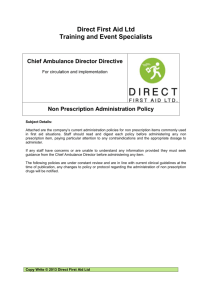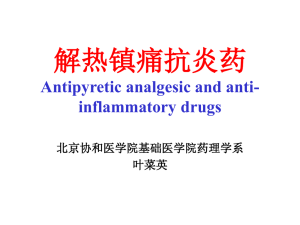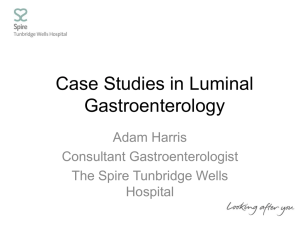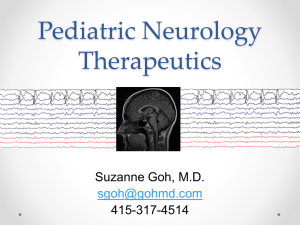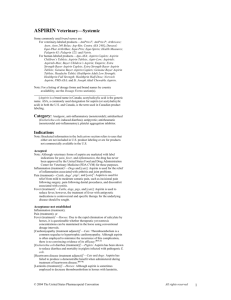Antipyretic analgesic Nonsteroidal anti-inflammatory drugs
advertisement
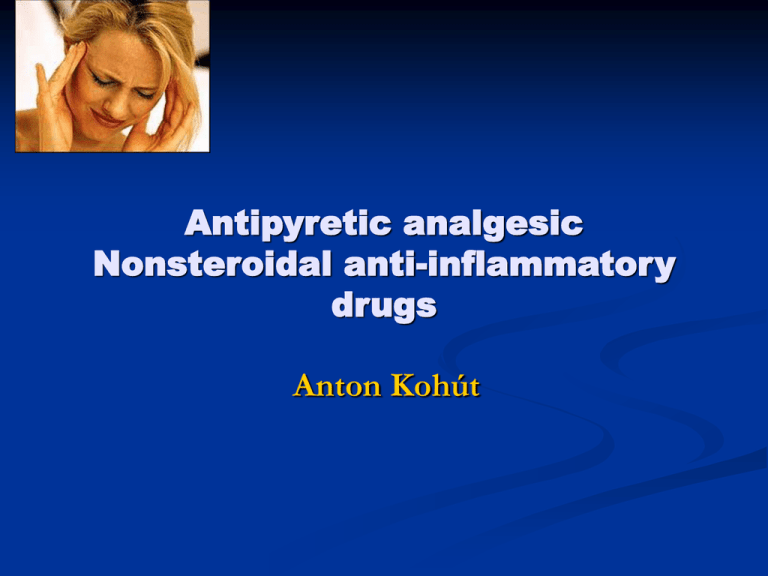
Antipyretic analgesic Nonsteroidal anti-inflammatory drugs Anton Kohút Pain perception Analgesics Salicylates- Aspirin Paracetamol Other nonsteroidal antiinflammatory drugs (NSAIDs) IV. Opioid analgesics Aspirin Salicin from Willow Bark. Biosynthesis of eicosanoids COX1 and COX2 Mechanism of action of aspirine Salicylates Drugs Acetylsalicylic acid (aspirin) Diflunisal Methylsalicylate Sulfasalazine Sodium salicylate Pharmacological actions Analgetic Antipyretic Antiinflammatory Antiagregatory Anticancerogenic Side effects of salicylates Gastrointestinal effects. Hepatic and Renal Effects Neurological effects (high doses stimulation followed by depression. Acid-Base balance Respiration. Salicylates stimulate respiration Uricosuric Effects. Low doses may decrease urate excretion. Large doses induce uricosuria. Small doses of salicylate can block the effects of probenecid and other uricosuric agents Side effects of salicylates - cont. Oxidative phosphorylation - the uncoupling of oxidative phosphorylation Carbohydrate metabolism- large doses hyperglycemia and glycosuria and deplete liver and muscle glycogen. Nitrogen metabolism - in toxic doses cause a significant negative nitrogen balance. Fat metabolism - reduce lipogenesis Endocrine effects- large doses of stimulate steroid secretion. Pregnancy- uses for long periods - reduced weights of babies. Pharmacokinetics of salicylates Absorption after p.o. are absorbed rapidly, After oral administration, the nonionized salicylates are passively absorbed from the stomach and the small intestine. Appreciable concentrations are found in plasma in less than 30 minutes; a peak value is reached in about 2 hours Rectal absorption is slower than after p. o. and is incomplete and unreliable; Salicylic acid is rapidly absorbed from the intact skin, especially when applied in oily liniments or ointments. Pharmacokinetics (cont.) Distribution - distributed throughout most body tissues and most transcellular fluids, primarily by pH- dependent passive processes, readily crosses the placental barrier and BBB (not diflunizal). The volume of distribution 13 l;. at high doses, increases to about 35 l 80% to 90% of the salicylate is bound to plasma proteins. Pharmacokinetics of salicylates (cont.) Elimination The biotransformation takes place in many tissues, but particularly in the liver. Are excreted in the urine as free salicylic acid (10%), salicyluric acid (75%), salicylic phenolic (10%) and acyl (5%) glucuronides, and gentisic acid (<1%). Half-life for aspirin is 15 minutes; that for salicylates is 2 to 3 hours in low doses and about 12 hours at usual antiinflammatory doses Effect of dose on the half-life of aspirin Aspirin (low dose) 10 9 8 (according to Lippincott´s Pharmacology, 2006 11 12 1 7 5 Aspirin (high dose) 2 3 4 t1/2 = 3 hours 12 1 11 12 1 2 10 2 3 9 3 4 8 7 6 5 t1/2 = 15 hours Therapeutic uses: a. Antipyretics and analgesics: Aspirin, sodium salicylate, choline salicylate, choline magnesium salicylate - used as antipyretics and analgesics: - headache, arthralgia, myalgia, - in the treatment of gout, rheumatic fever, and rheumatoid arthritis. Note: Salicylates are the drugs of choice in the treatment of rheumatoid arthritis. b. Diflunisal, a derivate of salicylic acid, is not metabolized to salicylate - it cannot cause salicylism. Diflunisal is 3-4 times more potent than aspirin as an analgesic and an antiinflammatory agent, but it does not have antipyretic properties. Note: Diflunisal does not enter the central nervous system (CNS) and therefore cannot relieve fever. Cardiovascular applications: inhibition of platelet aggregation. Low doses of aspirin are used prophylactically to decrease the incidence of transient ischemic attack and unstable angina in men as well as that of coronary artery thrombosis. Aspirin also facilitates Aspirin also facilitates closure of the patent ductus arteriosus (PGE2 is responsible for keeping the ductus arteriosus open). d. Colon cancer: Chronic use of aspirin may reduce the incidence of colorectal cancer. Therapeutic Uses of salicylates (dose depends on the wanted effect) Analgesia - headache, arthritis, dysmenorrhea, neuralgia, and myalgia. in the same doses and manner as for antipyresis Antipyretic- in the same doses and manner as for analgesia Rheumatoid arthritis - 2 to 6 g daily), Other uses - treatment or prophylaxis platelet hyperaggregability (dose of aspirin is 40 to 325 mg per day). Inflammatory Bowel Disease - mesalamine (5amino-salicyclic acid) Aspirin Usual dose Effect 80 – 160 mg Antiplatelet 325 – 1000 mg Analgesic, antipyretic 325 mg – 6 grams Antiinflammatory, tinnitus 6 – 10 grams Respiratory alkalosis 10 – 20 grams Fever, dehydration, acidosis > 20 grams Shock, coma Dose-dependent effects of salicylate Vasomotor collapse; Coma; Dehydration Plasma concetration of salicylate (mg/dL) 150 100 50 Severe Intoxication Mild Tinnitus Central hyperventilation Anti-inflammatory 10 0 (according to Lippincott´s Pharmacology, 2006 Lethal Analgesic Antipyretic Antiplatelet Gastric bleeding Impaired blood clotting Hypersensitivity reactions Preventive use of aspirine Paracetamol (acetaminophen) Paracetamol Pharmacological properties analgesic and antipyretic effects is only a weak inhibitor of COX. no effects on platelets, or the excretion of uric acid. Pharmacokinetics is rapidly and completely absorbed from the gastrointestinal tract. peak concentration in plasma in 30 to 60 minutes, and the half-life in plasma is about 2 hours After large doses of paracetamol, the metabolite (Nacetyl-benzoquinoneimine) is formed -and hepatic necrosis can result. HNCOCH3 HNCOCH3 HNCOCH3 Metabolism of paracetamol Sulfate OH Glucuronide Paracetamol Cytochrome P-450 mixed function oxidase Glutathione NCOCH3 Nucleophilic hepatic cell proteins Toxic doses Therapeutic doses O HNCOCH3 OH Glutathione Mercapturic acid (nontoxic) (according to Lippincott´s Pharmacology, 2006 Toxic intermediate HNCOCH3 OH Cell macro-molecules Cell death Paracetamol (cont.) Therapeutic Uses is a suitable substitute for aspirin for analgesic or antipyretic uses; Toxic Effects In therapeutic dosage is usually well tolerated. acute overdosage ( 2-3 g) is a dose-dependent, potentially fatal hepatic necrosis. Renal tubular necrosis and hypoglycemic coma also may occur. Toxicity is potentiated by ethanol antidot - N-acetylcysteine. Nonsteroidal antiinflammatory drugs NSAIDs Inflammation represents a series of homeostatic events that have evolved to aid in our survival in the face of pathogens and tissue injry. NSAIDs NSADS act as : 1. cytokine inhibitors ( IL-1, TNF, IL-8), antibodies or antibody fragments. Antagonists to various peptides that contribute to cytokine-mediated responses (e.g., substance P, bradykinin) also are in development. 2. inhibitors of cell adhesion molecules (these include soluble fragments of receptors to bind cell adhesion molecules and use of antibodies, peptides, and carbohydrate moieties to block cell adhesion molecules. 3. phospholipase A2 inhibitors - glucocorticoids but whose toxicity will be less frequent and severe than that of the steroids). 4. inhibitors of lipooxygenase and leukotriene receptors, 5. isoform specific inhibitors of cyclooxygenase (meloxicam). Classification of NSAIDs Indomethacin Pharmacological properties has prominent antinflammatory and analgesic-antipyretic properties, is more potent than aspirin. effects of indomethacin are evident in patients with rheumatoid and other types of arthritis, including acute gout. is evidence for both a central and a peripheral action; it also is an antipyretic. is also inhibitor of polymorphonuclear leukocytes. Pharmacokinetics After p. o. oral ingestion the peak concentration within 2 hours. Its concentration in synovial fluid is equal to that in plasma within 5 hours. Indomethacin is converted primarily to inactive metabolites, including those formed by O-demethylation (about 50%), conjugation with glucuronic acid (about 10%), and N-deacylation. 10% - 20% of the drug is excreted unchanged in the urine, in part by tubular secretion. The half-life averages about 3 hours. Indomethacin Therapeutic uses Analgesic-antipyretics Treatment of ankylosing spondylitis and osteoarthrosis, treatment of acute gout in obstetrics and neonatal medicine. - as a tocolytic agent to suppress uterine contractions. - cardiac failure in neonates caused by a patent ductus arteriosus Side effects about 20% must discontinue its use. Most adverse effects are dose-related. GIT some fatal cases of hepatitis and jaundice have been reported. most frequent is severe frontal headache. hematopoietic reactions include neutropenia, thrombocytopenia, and, rarely, aplastic anemia. diclofenac, felbinac, ibuprofen, ketoprofen, piroxicam, naproxen, flurbiprofen and others. Gout is a form of arthritis Development of gout Antirheumatic Drugs (drugs used to treat rheumatoid arthritis) The major classes of antirheumatic drugs include: 1. Nonsteroidal Anti-Inflammatory Drugs (NSAIDs: ibuprofen naproxen indomethacin . 2. Corticosteroids: prednisone and dexamethasone. Is classified as an auto-immune disease Physicians now use Disease Modifying AntiRheumatic Drugs (DMARDs) and Slow-Acting Antirheumatic Drugs (SAARDs). The major classes of antirheumatic drugs include: 1. Nonsteroidal Anti-Inflammatory Drugs (NSAIDs: ibuprofen (Motrin, Nuprin or Advil), naproxen (Naprosyn, Aleve) indomethacin (Indocin). 2. Corticosteroids: prednisone and dexamethasone. DMARDs influence the disease process itself and do not only treat symptoms -Antimalarials DMARDs include chloroquine (Aralen) and hydroxychloroquine (Plaquenil). - Immunosuppresive cytotoxic drugs: methotrexate, mechlorethamine, cyclophosphamide, leflunomide, cyclosporine A, chlorambucil, and azathioprine. - Slow-Acting Antirheumatic Drugs (SAARDs): are a special class of DMARDs and the effect of these drugs is slow acting and not so quickly apparent as that of the NSAIDs. Example is aurothioglucose (gold salt). - Monoclonal antibody: etanercept, infliximab antiTNFdrugs - Anakinra (recombinant interleukin-1 receptor antagonist) Monoclonal antibody: anti-TNF drugs: Adalimumab, etanercept, infliximab, leflunomide, Remicade
